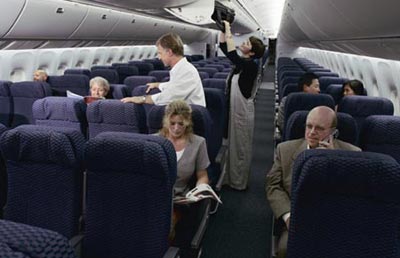Human factors in commercial suborbital flight: Getting adequate oxygenby John Jurist
|
| The cabin designer of a suborbital commercial spacecraft will have to perform a design tradeoff between minimizing cabin weight by pressurizing the cabin to the highest equivalent altitude possible while in space, and considering the demographic characteristics of the paying passengers. |
The two primary ways of dealing with this problem are to either breathe supplemental oxygen or to pressurize the cabin, or both. Commercial airline cabins were required to be pressurized to a maximum equivalent altitude of 3,000 meters (10,000 feet, or 523 mm Hg) until 1957, after which they were required to maintain a maximum allowed altitude of 2,500 meters (8,000 feet, or 564 mm Hg). Recent investigations by the National Research Council have raised concerns that the current 8,000-foot limit might have an adverse affect on some passengers and crew. A recent study by J. M. Muhm at Boeing concludes that “…a substantial proportion of older passengers will [have arterial oxygen levels at 8,000 feet that fall]… below the threshold at which supplemental oxygen is recommended.”
At the commercial standard of 8,000 feet, Muhm’s estimate was that 44 percent of healthy passengers aged 65 years or more will have inadequate arterial oxygen levels while breathing air. His estimates for younger, otherwise healthy, people were that 27 percent of those 55 years and older, and 14 percent of those 45 years and older fall into this category [Ref. 1].
Therefore, the cabin designer of a suborbital commercial spacecraft will have to perform a design tradeoff between minimizing cabin weight by pressurizing the cabin to the highest equivalent altitude possible while in space, and considering the demographic characteristics of the paying passengers. The changes in oxygen exchange within the lungs in the general population as a function of altitude are not well characterized. The military has performed extensive studies of this nature in well-defined, younger populations that match their air crew demographics, but how many of these people can afford to buy a ticket to space?
Reference:
1. Predicted Arterial Oxygenation at Commercial Cabin Altitudes. J. M. Muhm, Aviation, Space, and Environmental Medicine, Vol. 75, No. 10, pp. 905-912, Oct. 2004.
